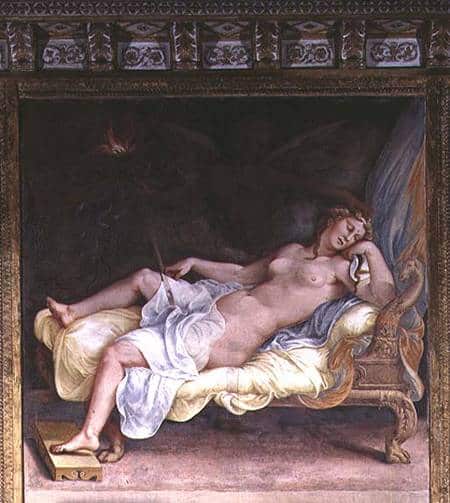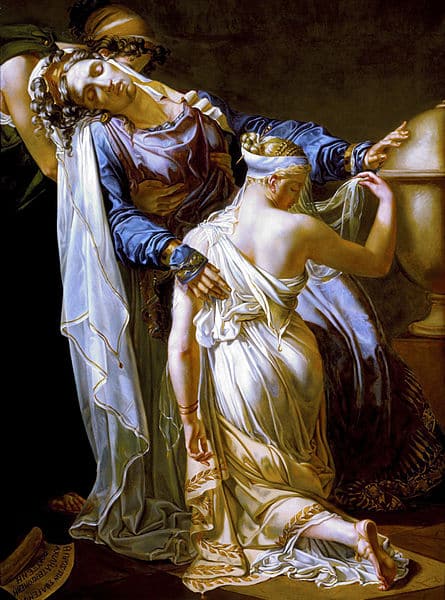In the vast realm of Greek mythology, few figures evoke as much sympathy as Hecuba, the once-proud queen of Troy. Her story, intertwined with the fates of many heroes of the Trojan War, is one of tragedy, resilience, and the inexorable whims of the gods.
Hecuba Key Facts
| Parents | King Dymas of Phrygia; Eioneus |
| Partners | Priam |
| Siblings | Not explicitly mentioned |
| Offspring | Hector, Paris, Cassandra, and many more |
| Other names | Hekabe |
| Roman name | Hecuba |
| Best Known Myth | Transformation into a dog after Troy’s fall |
Name and Etymology
Hecuba, or Hekabe in Greek, has origins that are somewhat shrouded in mystery. Some suggest her name might be derived from the ancient Greek word for “far off” – a nod, perhaps, to her distant and tragic fate. The Romans, ever the admirers of Greek culture, adopted many of their tales, including Hecuba’s, without altering her name.

Hecuba’s Family and Relationships
Born to King Dymas of Phrygia and Eioneus, Hecuba’s lineage was noble from the start. Her early life, though not as extensively documented as her later years, was presumably one of privilege and royalty. As she blossomed into womanhood, she was married to Priam, the king of Troy, and together they had many children, including notable figures like Hector, Paris, and the prophetic Cassandra.
Her son Paris’s infamous relationship with Helen led to the war, and her eldest, Hector, was Troy’s mightiest warrior. Amidst the backdrop of war, Hecuba faced immense personal tragedies, including the loss of many of her children. Her interactions with other key figures, such as Briseis, Menelaus, and Agamemnon, further highlight her central role in the epic saga.
Myths about Hecuba
The myths surrounding Hecuba are as captivating as they are tragic. Her life is deeply intertwined with the fate of Troy. Offering a window into the heart-wrenching realities faced by those caught in the crossfire between gods and mortals.
Hecuba and the Omen of the Burning City
Long before the Trojan War began, Hecuba experienced a haunting dream that would foreshadow the doom of her beloved city. In this dream, she didn’t cradle a newborn baby, as one might expect of a pregnant queen. Instead, she held a flaming torch, its fire consuming Troy. Distraught by the ominous vision, she consulted seers who interpreted the dream as a prophecy. They believed her unborn child would be the cause of Troy’s destruction.
After Hecuba and King Priam gave birth to Paris, they faced a heart-wrenching decision. To safeguard their city, they ordered their infant son to be left on Mount Ida, hoping nature would take him. However, fate, always cunning, had other plans. Shepherds raised Paris. However, he later discover his royal lineage and return to Troy, setting the stage for the city’s eventual downfall.
Hecuba’s Transformation: From Queen to Canine
The fall of Troy brought unimaginable sorrow to Hecuba. But one event pushed her grief to its limits: the discovery of her youngest son Polydorus’s lifeless body on a foreign shore. He had been entrusted to the care of Polymestor, the Thracian king. However, lured by greed, he murdered the young prince to claim his gold.
Blinded by rage and despair, Hecuba, along with other Trojan women, devised a plan. They lured Polymestor with the promise of gold, only to exact their revenge by blinding him and murdering his children. This act of vengeance, however, came at a steep price. The gods, viewing her act as an overstep of mortal boundaries, transformed Hecuba into a dog. Some say that, overwhelmed by her grief, she jumped into the sea. Consequently, a curse bound her to forever haunt its shores, crying out for her lost city and children.
Depiction And Characteristics
Hecuba’s portrayal in myths is one of a devoted mother and queen. Her appearance, though not as detailed as some other figures, is often that of an older, regal woman, befitting her status as the queen of Troy.
Her character is a testament to the strength of a mother’s love and the depths of her despair. The Ancient Greeks viewed her as a tragic figure, a representation of a city and family’s downfall through no fault of her own.
Representations Of Hecuba In Art
Throughout history, Hecuba’s tragic tale has moved many artists.
In classical art, artists often depict her amidst scenes of the Trojan War, showcasing her anguish and despair. One of the most poignant representations is “The Mourning of Hecuba,” where she’s seen lamenting the loss of her children and her city.
In later European art, her transformation into a dog became a popular theme, symbolizing the ultimate tragedy and the cruel whims of the gods.

Mentions in Ancient Texts
Each work offers a unique lens through which to view her life, her struggles, and her indomitable spirit.
Homer’s “Iliad” (c. 8th century BC)
Homer, the legendary blind poet often considered the cornerstone of ancient Greek literature, vividly brings Hecuba’s character to life in the “Iliad.” Written around the 8th century BC, this epic poem primarily focuses on the Trojan War’s final weeks.
Indeed, Hecuba stands out as the queen of Troy and the mother of its heroes. She actively interacts with Hector, and her plea for him to steer clear of combat with Achilles underscores her deep love and concern for her children. A notable excerpt reads:
“Hecuba, with tears in her eyes, pleaded with Hector not to face Achilles, for she feared she would lose her beloved son.”
Euripides’ “Hecuba” (c. 424 BC)
Euripides, one of ancient Greece’s three great tragedians, penned “Hecuba” around 424 BC. This play delves deep into Hecuba’s grief following the fall of Troy. It portrays her despair, rage, and eventual transformation, offering a raw and unfiltered look into her tragic fate. Euripides, known for his strong female characters and psychological insights, paints Hecuba as a symbol of suffering and resilience amidst adversity.
Ovid’s “Metamorphoses” (c. 8 AD)
The Roman poet Ovid, renowned for his narrative elegance, included Hecuba’s story in his magnum opus, “Metamorphoses,” written around 8 AD. Ovid’s portrayal emphasizes the cruel whims of the gods and the fragility of mortal happiness.
Seneca’s “Trojan Women” (c. 54-62 AD)
Seneca the Younger, a Stoic philosopher, statesman, and dramatist of ancient Rome, revisited the tale of Hecuba in his play “Trojan Women.” Written between 54-62 AD, this work is a Latin reimagining of Euripides’ play of the same name. Seneca, known for his intense and emotional style, delves into the aftermath of Troy’s fall, with Hecuba’s anguish taking center stage. He writes:
“Great Troy is fallen; I have lost my kingdom.”
Frequently Asked Questions
Hecuba dreamt of giving birth to a torch that set Troy on fire, symbolizing Paris’s role in Troy’s downfall.
She was married to Priam, the king of Troy.
Overwhelmed with grief, she took revenge on Polymestor for killing her son. As punishment the gods transformed her into a dog.
Yes, she had significant interactions with figures like Briseis, Menelaus, and Agamemnon.
It symbolizes her tragic fate and the cruel whims of the gods.
Featured Image Credit: Virgil Solis, Public domain, via Wikimedia Commons
